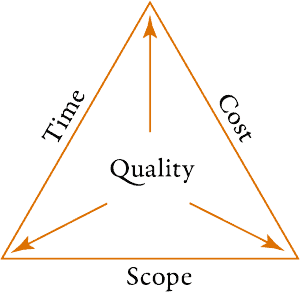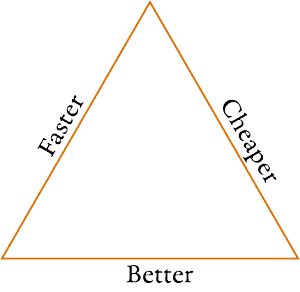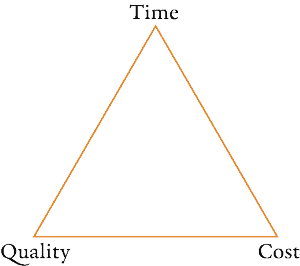
Priorities and Balance
Have you ever worked on a project with no deadlines, unlimited resources, and boundless scope? Probably not.

You may have worked under the guidelines of a quality triangle, also known as a project management triangle, iron triangle, or project triangle.
Why is that? Why the limits to our ability to create a product or improve a system?
First, the world we work and live within has limits. We have only so much time for work, only the available resources, and limited knowledge. We do our best with what we have to work with at the time.
Second, as I once was told while working on an accelerated test design, ‘if there isn’t a deadline, you’ll happily tinker with the plan and get the testing done.’ My boss was right of course.
The set of constraints shape our projects and products. By understanding the set of constraints, specifically how they frame decisions, then we can complete complex projects.
Traditional Tradeoffs

Numerous trade journal articles include a starting line concerning the increasing speed of product development cycles. The notion of increased pressure to make products faster, cheaper, and better in order to meet customer expectations is pervasive.
The triad traditionally includes time, cost, and quality. Andy Oppel suggests the initial use of a triangle to establish priorities originated with movie producers attempting to create a high-quality movie experience, quickly, and on a small budget.
Andy Oppel, 2009. Data Modeling: A Beginner’s Guide by Oppel, Andy (2009) Paperback, McGraw-Hill.
Dr. Martin Barnes introduced the triangle of objectives in the mid-1980s. Lock, Dennis. 2013. Project Management. 10th edition. Burlington, VT: Gower. http://site.ebrary.com/id/10665950.
Time: Meeting time to market targets not only sets a deadline for the team, but it also provides a mechanism for marketing, sales, promotions, and customer expectations around new product launches.
The time constraint may be business-driven given the increased revenue with new products. Or, the constrain may be seasonal. Holiday sales, life event connections (graduations and weddings), or major industry conferences all provide external-driven time constraints.
 Cost: This breaks down into at least two major buckets. The development team and supporting systems have a cost. Salaries, office buildings, computers, etc. All have a cost whether or not a product launches.
Cost: This breaks down into at least two major buckets. The development team and supporting systems have a cost. Salaries, office buildings, computers, etc. All have a cost whether or not a product launches.
Likewise, the product itself has a cost. Often called the bill of material costs it is part of the cost of goods sold. If you sell a widget for $100 and the materials, components, and assembly process combined cost $50 (cost per item produced) then there are $50 for marketing and selling costs leaving the remainder for profit.
Quality: One consideration when developing a product is how the finished product fits in the pantheon of available solutions. Your team may aim to create the luxury or deluxe solution in your space, or create a minimally viable product without any bells or whistles.
The selection of materials, the setting of tolerances, the types, and the nature of features all involve the resulting quality of a product.
Time, Cost, and Quality can all become high priorities. The conventional wisdom is ‘pick two’. Let the third go.
If you want a product on time with a low cost, the team will likely have to cut functions, open tolerances, or sacrifice quality.
Setting priorities to achieve a high-quality product to meet a product launch window, the team may need additional money to hire staff, build prototypes faster, and use the best materials while adding the luxury set of features.
Given a budget for development and product costs yet wanting to meet specific quality levels may require more time to accomplish.
Fast, Good, Cheap is another triad invoking the same set of constraints. Here the idea is customers want solutions that are better, less expensive, and available sooner than in the past.
The Project Management Triangle
A tool for project management separates scope (product or system feature set, deliverables, and specifications) and quality. The triangle has Scope, Cost, and Time on the corners with Quality in the middle.
The idea is the effect of decisions concerning scope, cost, or time will impact the resulting quality. In this configuration, quality is seen as a relatively fixed target while the project manager has control of the other three elements.
Making the priorities for the four listed elements in the triangle explicit serves to guide decision-making across the organization. If time is the critical priority, then the decision that saves time or meets the deadline is a clear choice.
Priorities and Balance with Planning and Flexibility
A good practice in project management using this tool is to also establish thresholds that trigger consideration of priorities and goals. For example, if meeting the time to market goal requires eliminating critical product functionality or increase cost to an unprofitable level, then the project may need to ‘slip’ providing more time to meet the acceptable scope and cost targets.
The priorities are guidelines. If product profitability is the top priority, the development team can cost reduce a product by eliminating components, or streamlining production thus increasing profitability.
Of course, time, scope, cost, and quality are not the only constraints to consider. Risk, resources (people, skills, equipment), Robustness (reliability), Utility, Beauty or Elegance, provide a longer list. Your business, product, industry, and customers will help you set priorities. Using the quality triangle helps you communicate and understand the important tradeoffs for your decision-making.
I look forward to studying your articles.
enjoy and if you have any questions please send them along or add via the comment field
cheers,
Fred
You never stop learning. Your articles will help me to meeting my continuous learning goal